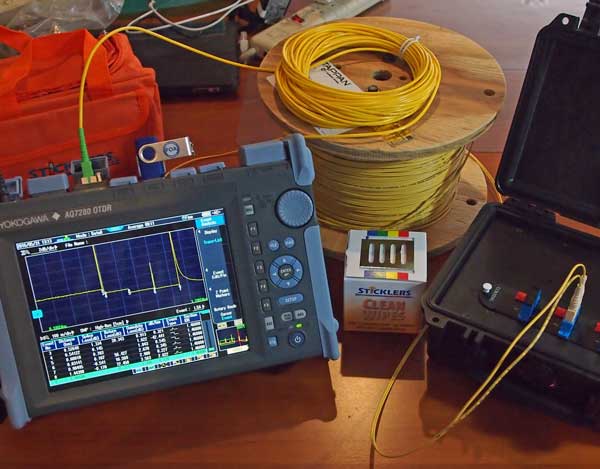A advanced optical fibre diameter analyser supports fibre manufacturing.
Discovering the Conveniences of Optical Fiber Testing for Improved Interaction Systems
The significance of optical fibre screening in modern interaction systems can not be overstated, as it acts as a foundation for guaranteeing network reliability and efficiency. Utilizing advanced methods such as Optical Time-Domain Reflectometry (OTDR) and insertion loss evaluation, companies can not only identify faults yet likewise optimize their arrangements. This aggressive screening method has profound ramifications for signal top quality and operational effectiveness, raising the concern of how these practices add to long-term sustainability in an ever-evolving technical landscape. Comprehending these characteristics is necessary for stakeholders intending to keep a competitive edge.
Importance of Optical Fibre Testing
The relevance of optical fiber screening can not be overemphasized in today's data-driven setting. As organizations significantly rely upon high-speed information transmission for day-to-day operations, the stability and performance of optical fiber networks are paramount. Checking ensures that these networks can support the large amounts of data generated and transferred perfectly, fostering effective communication and connection.
Optical fiber testing serves several important features, including validating installation high quality, determining prospective faults, and determining overall system efficiency. Normal screening can prevent costly downtimes and service disturbances, permitting companies to keep functional connection. Furthermore, it assists in compliance with market criteria and policies, making certain that fibre optic installments satisfy required requirements for safety and security and integrity.
Additionally, testing can enhance the long life of fibre optic systems. By proactively identifying issues such as signal loss, attenuation, or port failings, companies can resolve problems before they intensify, therefore extending the life of their framework. In summary, optical fiber testing is not merely a technological requirement but a calculated investment that improves network integrity, enhances performance, and ultimately sustains the development and effectiveness of contemporary interaction systems.
Trick Checking Techniques

OTDR is a vital method utilized to identify mistakes, step splice losses, and examine the overall integrity of a fiber optic web link. By sending a pulse of light down the fiber and analyzing the mirrored light, technicians can identify areas of faults and assess the network's efficiency over cross countries.
Insertion loss screening gauges the amount of signal loss that happens when light travel through a connection or splice. This approach is critical for verifying that connections fulfill given loss thresholds, which is necessary for keeping optimal reference performance in interaction systems.
Optical return loss screening evaluates the amount of light mirrored back towards the source due to blemishes in the fiber or links. High return loss worths indicate far better efficiency and minimized signal degradation.
Together, these screening techniques give an extensive analysis of fiber optic networks, ensuring their dependability and performance in diverse interaction applications.
Influence On System Efficiency
Efficient optical fiber screening directly influences the general performance of interaction systems. By making certain the integrity of fibre optic cable televisions, screening identifies possible faults such as attenuation, splice loss, and connector imbalance. These issues can considerably deteriorate signal high quality, resulting in disturbances and reduced data transmission rates.

Additionally, normal optical fibre testing adds to lasting system sustainability. It makes it possible for very early detection of damage, permitting prompt upkeep and upgrades prior to major failings occur. This not only prolongs the life expectancy of the facilities yet additionally guarantees that interaction systems remain affordable in regards to efficiency.
Cost-Effectiveness and Effectiveness
Cost-effectiveness is an essential factor to consider in the implementation and upkeep of optical fibre additional resources networks. Carrying out robust optical fibre testing procedures can considerably decrease functional prices by recognizing problems prior to they intensify right into significant issues. optical fibre testing equipment. By discovering faults, depletion, and various other performance barriers early, organizations can avoid costly repair services and downtime, which can disrupt solutions and lead to revenue loss
Furthermore, reliable screening techniques simplify the installment process, permitting specialists to work a lot more efficiently. This converts to lower labour expenses and faster project completion times. Advanced screening tools, such as Optical Time Domain Reflectometers (OTDRs), enables an accurate analysis of fibre high quality, making certain that just optimum products are used, thus minimizing waste.
Regular testing additionally contributes to far better source allotment. By comprehending the network's efficiency, companies can make educated choices concerning upgrades and growths, making certain that financial investments are made where they are most required. In summary, optical fiber screening improves cost-effectiveness and efficiency, sustaining the long-lasting sustainability and competition of communication systems in a significantly requiring market.
Ensuring Long-Term Dependability
Carrying out rigorous optical fibre screening not just improves expense savings and operational effectiveness but likewise plays a critical duty in ensuring the long-term reliability of communication networks. Constant testing methods, including depletion and try these out bandwidth analyses, assistance recognize possible degradation in fibre efficiency prior to it results in solution disturbances.
By using innovative screening methods, network drivers can pinpoint mistakes or weak points in the fibre framework, enabling prompt remediation. This positive method lessens downtime, ensuring that communication systems remain useful and reliable. Routine screening adds to the advancement of a more resistant network, as drivers can adjust and optimize their framework based on real-time information insights.
In addition, making certain conformity with market standards through optical fiber testing strengthens the top quality and integrity of the entire interaction system. This adherence not only reinforces confidence amongst stakeholders but also lines up with regulatory requirements, which are increasingly rigorous.
Final Thought
In conclusion, optical fibre screening offers as a fundamental element in boosting communication systems. By employing various testing techniques, such as OTDR and insertion loss evaluations, networks can achieve optimal efficiency and integrity.